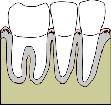 |
 |
 |
 |
 |
 |
HOME CARE
The responsibility of controlling the disease process rests completely with the PATIENT ! This is not to say that professional care (i.e. diagnosis, education, therapy) is not necessary - it's just that MANY people that have had the best of care, do not perform the diligent home care regimen they should. Once a person has been diagnosed, they forever have periodontal disease. There is NO cure - it can only be maintained, and should be reevaluated at regular intervals so as not progress to the point of tooth loss. One of the biggest misconceptions concerning periodontal disease is that the dentist / hygienist will control the disease.
Bacteria is the primary culprit. Bacteria
are present in everyone's mouth. Some types of bacteria are much more aggressive
than others.
|
|
|
|
|
|
| What is the cause of most tooth loss in adults? | Periodontal disease - NOT decay |
| Can I inherit this problem? | Yes, you can. You may inherit the problem of unusually heavy plaque and tartar buildup, or even problems with your immune system which leave you much more susceptible. |
| Can I tell that I'm having this problem myself? | Not in the earliest stages, it takes a dentist or hygienist using a special instrument to determine early onset. |
| If my gums bleed when I brush, am I in desperate trouble? | Not necessarily.........but.........the earlier the treatment, the more likely long-term success. |
| Does everyone diagnosed require surgery? | Not at all. In fact conservative therapy has proven to be successful in the majority of cases diagnosed early. |
| Is bad breath a sign of periodontal problems? | Possibly, because the very same bacteria can cause both problems. |
| How long does it take for plaque to reform after a professional cleaning? | 1 day |
| Are there are factors besides bacteria? | Yes, stress, poor nutrition, a poor bite and especially smoking. |
| If bacteria causes most periodontal problems, is there an antibiotic that is effective? | No, and the reason for this is that there are a multitude of bacteria (not just one) that causes this disease. |
The terms periodontal disease, gum disease and pyorrhea are all synonymous terms. Periodontal disease is the most common disease in the world, it is estimated that over 70% of the adult population in this country have some periodontal problems..
Periodontal Disease is a chronic infection that slowly attacks and destroys the gums and bone that support the teeth. The fact that it is a chronic disease means that a person can not be "cured", rather they must work at controlling the factors which will bring on the full disease process. Other examples of chronic disease are heart disease and diabetes - they can be managed, but NOT cured.
Defining terms:
 |
|
 |
|
 |
|
 |
|
X-rays play a vital part in the overall diagnosis of periodontal disease. They compliment the periodontal pocket charting.
|
In this x-ray, the bone and supporting tissues are normal. Your gums don't show up on x-rays but the bone does. The red line is drawn across the top of the bone seen on the film. |
 |
|
PERIO BONE LEVEL |
 |
The usual treatment sequence after proper diagnosis and documentation is performed is:
SCALING consists of removing the hard calculus and plaque around the collar of the tooth as well as below the gumline. ROOT PLANING removes the calculus and plaque off the root surface well below the gumline (into the pocket). Depending on the case, these procedures may or may not require numbing. Hand instruments called scalers as well as high-frequency polishers will be used to accomplish a complete and thorough job.
When the pockets are very deep, procedures must be performed so that all infection, plaque and calculus may be removed. Sometimes the bone around is no longer smooth and it must be corrected. There are times that bone may be actually added to areas where it has eroded away.
